Baseboards: instead of Quarter round
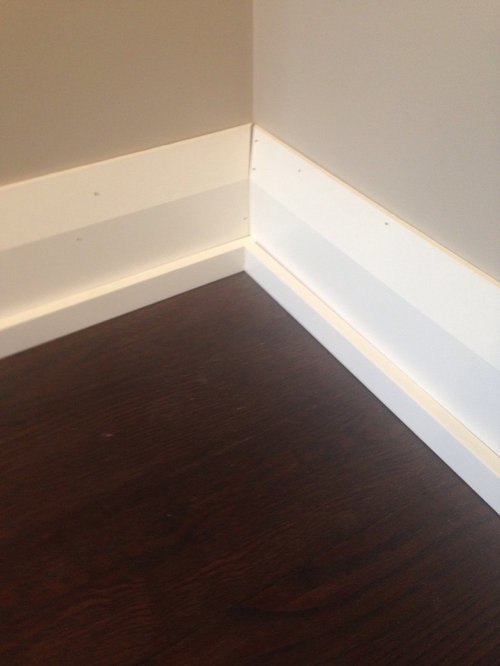
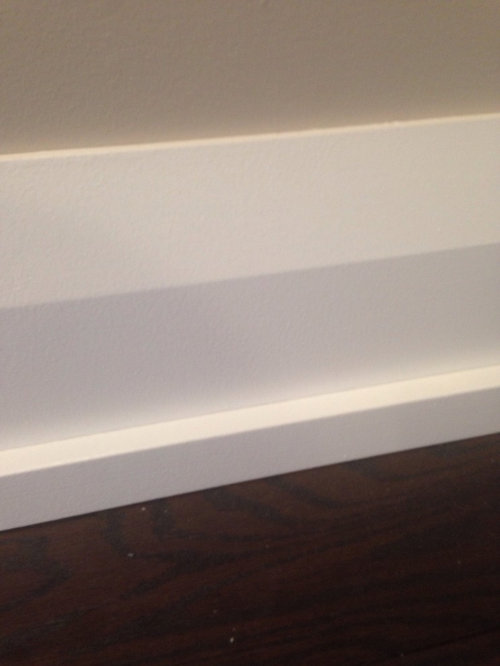
Commenti (14)
- 8 anni fa
The whole reason behind quarter is to hide the expansion gap of the flooring against the baseboard. That isn't really wide enough to do that. Which means your flooring below doesn't have enough expansion gap. Which is a MUCH bigger problem than the fact that you think quarter isn't attractive.
- 8 anni faRedoing our flooring in a 19th century home. We were just talking about quarter round (we gotta do it) and lose an inch on our 12" baseboards. Yes,
I'm comparing baseboard length.
Sorry if that was inappropriate.
I like this look with the square. I would have never thought about it. It looks more modern to me and so I don't know your house I can't comment on that. Personally I would run with it!
From an install standpoint: quarter round works well because it is flexible and so you can mold it to the floor and original baseboard for a tight finish. What you have chosen may be a bit more difficult and require more/larger nails. A newer home probably won't have those issues. - 8 anni faUltima modifica: 8 anni fa
It appears that your baseboard DOES cover the expansion gap between the floor and the drywall. The really tall baseboards are much thicker at the bottom than the smaller baseboards used in your average home.
Frankly, I think quarter round is much more attractive than the additional flat peice you are using. If the baseboard totally covers the expansion gap without it, you don't need to use anything else at all, if you don't want to. It's your house and you're the one that needs to be happy about it. But the quarter round really adds the finishing touch and a professional trim carpenter wouldn't be happy about leaving the job in an "unfinished" state.
Here is my eight inch baseboard with quarter round.
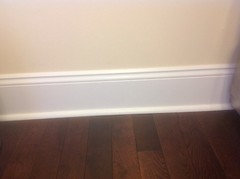
- 8 anni faTo respectfully disagree with the pro. Keeping in mind they are the pro and have done this once or twice...
Your floors should be run under your back baseboard up to the Sheetrock but not to the wall plate (horizontal 2x4). That space would be for floor expansion. The baseboard will traditionally hide that gap with no need for 1/4 round.
Looks like in your pic it hides the floor expansion gap nicely.
If you are putting in new floors, the installer will tell you how big a gap he is leaving (depending on material, environment, and his comfort level) it could be anywhere from 3/8" - 3/4". - 8 anni fa
Replacement floors do not run under the base. They should stop short around 3/8"-1/2" from the base, depending on season and material. That gap is what quarter covers.
- 8 anni fa
The square edge on your quarter round substitute will be banged up and dented by the vacuum cleaner in no time. If you really don't want quarter-round, look for a shoe molding that has an bevelled top. That bevel will echo the larger baseboard bevel and not be so subject to damage.
- 8 anni fa
I think a great deal of what is or isn't used has to do with the part of the country you happen to live in. The hundred year old houses here have quarter round at the bottom of the baseboards. It certainly had nothing to do with what was available at a "big box store".
- 8 anni faI would be worried that the flat top will collect dust and cast shadows. Look at your pic, there are four stripes along the floor (bevel, baseboard, top and vertical of bottom piece you propose including) bc horizontal top and vertical bottom each catch light differently as opposed to rounded moulding that reflects light as one piece (see first pic in comments). If you like it, keep it. But to me it breaks up the dramatically tall baseboard like an ankle strap on a shoe shortens the look of a leg.
- 8 anni fa
I have done something similar with a different style baseboard (and a taller piece than yours in place of the shoe molding) of the same height. It gives a nice, distinctive appearance and looks more substantial. I got the idea from a house on the Delaware shore that had really nice, clean lines on baseboards unlike any I had ever seen, and the small trim was similar (but with an eased edge rather that sharp 90 degree).
On the other hand, the inside corners on your baseboards seem to have been done improperly. They appear to have been mitered rather than coped. Coping will hide seasonal expansion better.
As a final touch, I'd caulk the seam between the shoe and the baseboard and give it a final coat of paint to make it look more monolithic and unified. Hit the nail heads and corners too.
- 6 anni fa
I have a similar problem. New construction house. Moulding is all shaker style, with no miter corners anywhere. Baseboard is flat. No quarter round. But we'd like some kind of moulding at the bottom of the base because as the house has shifted, there are some gaps, especially on the outside walls. I like her solution but agree with the corners getting dinged. I saw some moulding in an old house that was sort of like an isoceles triangle in profile. A very short top and angled front.
0 - 6 anni faHome Depot has shoe moulding, slightly taller than its width.
Lots of other styles to look at too.0 - 2 anni fa
Real shoe molding is used when current baseboards are kept an a new floor is installed! We install them after the floor has been installed! The 10 to 15 dollar a square foot wood floors we install are most definitely not a mistake!
0 - 2 anni fa
I’m all about thinking outside the box. I’m about to do the same thing and didn’t want to use quarter round… i think it’s dated. There are many creative options to cover that gap and make it look more modern and up to date. Thumbs up from me. It looks great!!! 👍👍

Ricarica la pagina per non vedere più questo specifico annuncio
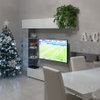

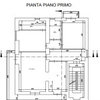
GannonCo